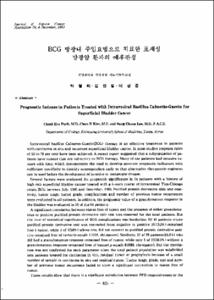BCG 방광내 주입요법으로 치료한 표재성 방광암 환자의 예후판정
- Keimyung Author(s)
- Park, Choal Hee; Kim, Chun Il; Lee, Sung Joon
- Department
- Dept. of Urology (비뇨의학)
- Journal Title
- 대한암학회지
- Issued Date
- 1991
- Volume
- 23
- Issue
- 4
- Abstract
- Intravesical bacillus Calmette-Guerin(BCG) therapy is an effective treatment in patients with carcinoma in situ and recurrent superficial bladder cancer. In most studies response rates of 56 to 79 per cent have been achieved A recent report suggested that a subpopulation of patients have tumors that are refractory to BCG therapy. Many of the patients had invasive tumors with time, which demonstrates the need to develop accurate prognostic indicators with sufficient specificity to identify nonresponders early so that alternative therapeutic regimens can be used before the development of invasive or metastatic disease.
Several factors were evaluated for prognostic significance in 64 patients with a history of high risk superficial bladder cancer treated with a 6-week course of intravesical Tice-Chicago strain BCG between July, 1985 and December, 1990. Purified protein derivative skin test reactivity, tumor stage,tumor grade, complications and number of previous tumor recurrences were evaluated in all patients. In addition, the prognostic value of a granulomatous response in the bladder was evaluated in 38 of the 64 patients.
A significant correlation between status free of tumor and the presence of either granulomatous or positive purified protein derivative skin test was observed for the total patients. But the level of statistical significance of BCG complications was borderline. Of 41 patients whose purified protein derivative test was converted from negative to positive 30(73,2%) remained free f tumor, while 3 of 6(50%) whose test did not convert to purified protein derivative positive remained free of tumor(p equals 0.0028, chi-square). Similarly, 21 of 25 patients(84.0%) who did had a granulomatous response remained free of tumor» while only 5 of 13(36.5%) without a granulomatous response remained free of tumor( p equals 0.0265, chi-square). But the correlation was not confirmed for each parameter when the total patient population was subdivided into patients treated for carcinoma in situ, residual tumor or prophylaxis because of a small number of sample in carcinoma in situ and residual tumor. Tumor stage, grade, size and number of previous tumor recurrence failed to show a significant correlation to status free of tumor.
These results show that there is a signficant correlation between PPD responsiveness or the presence of granulomas and response to BCG therapy, suggesting a possible link between immune responsiveness and BCG-mediated antitumor response. The predictive indexes of PPD and a granulomatous response, while suggestive of the therapeutic efficacy, lack sufficient accuracy for use as prognostic indicators in governing therapy for individual patient.
- Alternative Title
- Prognostic Indexes in Patients Treated with Intravesical Bacillus Calmette-Guerin for Superficial Bladder Cancer
- Publisher
- School of Medicine
- Citation
- 박철희 et al. (1991). BCG 방광내 주입요법으로 치료한 표재성 방광암 환자의 예후판정. 대한암학회지, 23(4), 835–842.
- Type
- Article
- ISSN
- 0496-6872
- Appears in Collections:
- 1. School of Medicine (의과대학) > Dept. of Urology (비뇨의학)
- 파일 목록
-
-
Download
 oak-bbb-02728.pdf
기타 데이터 / 285.22 kB / Adobe PDF
oak-bbb-02728.pdf
기타 데이터 / 285.22 kB / Adobe PDF
-
Items in Repository are protected by copyright, with all rights reserved, unless otherwise indicated.